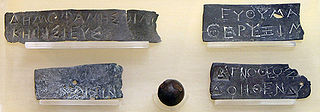Pandionis is a phyle (tribes) of ancient Attica which had eleven demes at the time of the creation of the phyle, which is when the phyle was created as part of a group of ten phylai. [1]
The names of the demes of Pandionis are Angele, Konthyle, Kydathenaion, Kytheros, Myrrhinous, Oa, Lower Paiania, Upper Paiania, Prasiai, Probalinthos, Steiria. [2]

In Ancient Greece, a deme or demos was a suburb or a subdivision of Athens and other city-states. Demes as simple subdivisions of land in the countryside seem to have existed in the 6th century BC and earlier, but did not acquire particular significance until the reforms of Cleisthenes in 508 BC. In those reforms, enrollment in the citizen-lists of a deme became the requirement for citizenship; prior to that time, citizenship had been based on membership in a phratry, or family group. At this same time, demes were established in the main city of Athens itself, where they had not previously existed; in all, at the end of Cleisthenes' reforms, Athens was divided into 139 demes. to which one should add Berenikidai, established in 224/223 BC, Apollonieis and Antinoeis (126/127). The establishment of demes as the fundamental units of the state weakened the gene, or aristocratic family groups, that had dominated the phratries.
Phyle is an ancient Greek term for tribe or clan. Members of the same phyle were known as symphyletai, literally: fellow tribesmen. They were usually ruled by a basileus. Some of them can be classified by their geographic location: the Geleontes, the Argadeis, the Hopletes, and the Agikoreis, in Ionia ; the Hylleans, the Pamphyles, the Dymanes, in the Dorian region.

Gerakas is a suburb of Athens and a former municipality in East Attica, Greece. Since the 2011 local government reform it is part of the municipality Pallini, of which it is the seat and a municipal unit.
The trittyes, singular trittys, were population divisions in ancient Attica, established by the reforms of Cleisthenes in 508 BC. The name means "third". There were thirty trittyes and ten tribes in Attica. Each tribe was composed of three trittyes, one from the coast (paralia), one from the city (asty), and one from the inland area (mesogeia). Trittyes were composed of one or more demes; demes were the basic unit of division in Attica.
Erchia or Erkhia was a deme of ancient Attica, of the phyle of Aegeis, sending six or seven delegates to the Athenian Boule, but eleven delegates after 307/6 BCE. According to Stephanus of Byzantium, in Greek mythology, the name comes from an inhabitant of the deme who hosted Demeter.
Acamantis was one of the phylai (tribes) of classical Athens, created during the reforms of Cleisthenes. It was named after the legendary hero Acamas, and included the demes of Cholargos, Eiresidai, Hermos, Iphistiadai, Kerameis, Kephale, Poros, Thorikos, Eitea, Hagnous, Kikynna, Prospalta and Sphettos.
Angele was a deme of ancient Attica, of the phyle of Pandionis, sending two, three, or four delegates to the Athenian Boule.
Antiochis was one of the ten tribes (phylai) into which the Ancient Athenians were divided.
Pandion was the eponymous hero of the Attic tribe Pandionis, which was created as part of the tribal reforms of Cleisthenes at the end of the sixth century BC. He is usually assumed to be one of the two legendary kings of Athens, Pandion I or Pandion II.
Cydathenaeum or Kydathenaion was one of the demes in ancient Athens. It belonged in the phyle (tribe) Pandionis.
Alopece was an asty-deme of the city of Athens, but located exterior to the city wall of Athens. Alopece was situated only eleven or twelve stadia from the city, and not far from Cynosarges. It possessed a temple of Aphrodite, and also apparently one of Hermaphroditus.
Aiantis was a phyle of ancient Attica with six demes, the deme with the greatest area was Aphidna.
Erechtheis was a phyle (tribe) of ancient Athens with fourteen demes.
Aigeis is the tribe name of a phyle of Ancient Greece who as a tribal group inhabited a number of demes of the area of Greece known as Attica.
Leontis is a phyle which had twenty demes at the time of the creation of the phyle, which is at the time of the creation of a group of ten phylai.
Phegaea or Phegaia was a deme of ancient Attica in the phyle of Pandionis.
Phegaea or Phegaia may refer to either of two demoi of ancient Attica:
Lower Ancyle or Ankyle Hypenerthen was the name of a deme of ancient Attica. It was located east of Athens and bordering Agryle to the south. Upper Ancyle passed from the phyle Aigeis to Antigonis in 307/306 BCE; Lower Ancyle remained in the Aigeis phyle.
Conthyle or Konthyle was a deme of ancient Attica, originally of the phyle of Pandionis, but after 224/3 BCE of the phyle of Ptolemais, sending one delegate to the Athenian Boule. There was an association among Conthyle, Cytherus, and Erchia.
Oa or Oae or Oai was a deme of ancient Attica, originally of the phyle of Pandionis but after 127/8 CE, of the phyle of Hadrianis, sending four delegates to the Athenian Boule.

